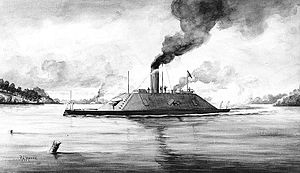CSS Richmond

| |
| History | |
|---|---|
| Name | Richmond |
| Ordered | 1862 |
| Laid down | March 1862 |
| Launched | 6 May 1862 |
| Commissioned | July 1862 |
| Fate | Burned and scuttled 3 April 1865 |
| General characteristics | |
| Length | 172 ft 6 in (52.58 m) |
| Beam | 34 ft (10 m) |
| Draft | 12 ft (3.7 m) |
| Propulsion | Steam engine |
| Speed | 5 to 6 knots |
| Complement | 150 officers and men |
| Armament | 4 rifled guns, 2 shell guns, 1 spar torpedo |
CSS Richmond, an ironclad ram, was built for use in the American Civil War at Gosport (Norfolk) Navy Yard to the design of John L. Porter with money and scrap iron collected by the citizens of Virginia, whose imagination had been captured by the ironclad CSS Virginia. Consequently, she was sometimes referred to as Virginia II, Virginia No. 2 or Young Virginia in the South and as Merrimack No. 2, New Merrimack or Young Merrimack by Union writers, months before the actual CSS Virginia II was ever laid down.
Begun in March 1862, Richmond was launched May 6 and towed up to the Confederate capital that very night to escape Federal forces again in possession of Norfolk Navy Yard and the lower James River. Richmond was thus finished at Richmond, Virginia in July 1862 and placed in commission by Commander , CSN as part of the James River Squadron. Twenty-two inches of yellow pine and oak plus 4 inches of iron on her casemate protected her roof, and "she is ironed 3½ feet below her load lines," wrote Shipyard Superintendent John H. Burroughs.
During 1863 and early 1864 the James front was quiet, but from May 1864 momentous events followed in quick succession. The Confederate Navy had three new ironclads in Captain French Forrest's squadron there, and minor actions were frequent.
During 1864 Richmond, under Lieutenant William Harwar Parker, CSN, took part in engagements at Dutch Gap on August 13, Fort Harrison on September 29 – October 1, and Chaffin's Bluff on October 22. On January 23–24, 1865, she was under heavy fire while aground with Virginia II above the obstructions at — at an angle that caused Federal projectiles to ricochet harmlessly off their casemates. But Richmond's unarmored tender, CSS Scorpion, being lashed alongside Richmond, was severely damaged by the explosion of CSS Drewry's magazine. The ironclads were forced to withdrew under the Confederate batteries at Chaffin's Bluff. A few weeks later, however, Richmond had to be destroyed to avoid capture by order of Rear Admiral Raphael Semmes, CSN squadron commander, prior to the evacuation of the Confederate capital on April 3.
Commanders[]
The commanders of the CSS Richmond were:[1]
- Commander (November 1862 – May 1864)
- Commander William Harwar Parker (May–June 1864)
- Lieutenant (July–October 26, 1864)
- Commander William A. Webb (October–November 1864)
- Commodore John McIntosh Kell (December 30, 1864-February 1865)
- Lieutenant (February 1865-)
- Passed Midshipman (during February 1865)
Notes[]
- ^ Coski (1996), John M. Capital Navy: The Men, Ships and Operations of the James River Squadron, Campbell, CA: Savas Woodbury Publishers. ISBN 1-882810-03-1.
References[]
- Bisbee, Saxon T. (2018). Engines of Rebellion: Confederate Ironclads and Steam Engineering in the American Civil War. Tuscaloosa, Alabama: University of Alabama Press. ISBN 978-0-81731-986-1.
- Silverstone, Paul H. (2006). Civil War Navies 1855–1883. The U.S. Navy Warship Series. New York: Routledge. ISBN 0-415-97870-X.
- Still, William N., Jr. (1985). Iron Afloat: The Story of the Confederate Armorclads (Reprint of the 1971 ed.). Columbia, South Carolina: University of South Carolina Press. ISBN 0-87249-454-3.
- This article incorporates text from the public domain Dictionary of American Naval Fighting Ships.
- Ironclad warships of the Confederate States Navy
- Ships built in Portsmouth, Virginia
- 1862 ships
- Scuttled vessels
- Ship fires
- Shipwrecks of the American Civil War
- Shipwrecks in rivers
- Maritime incidents in April 1865
